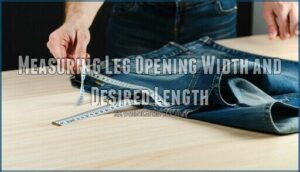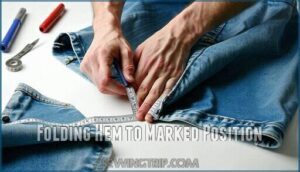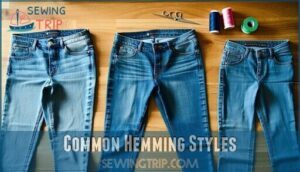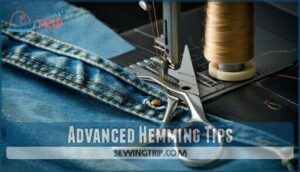This site is supported by our readers. We may earn a commission, at no cost to you, if you purchase through links.
 You’re about to master the art of hemming jeans. To get started with how to hem jeans, you’ll need a sewing machine, denim needle, and thread.
You’re about to master the art of hemming jeans. To get started with how to hem jeans, you’ll need a sewing machine, denim needle, and thread.
Try on your jeans, mark the desired hem length, and fold the raw edge up by about 1/4 inch. Then, fold it again to create a hem allowance, and pin it in place.
Sew along the folded edge, close to the original hem, and you’ll have a professional-looking finish. Now, let’s take it to the next level with some expert tips on preserving that original hem stitch.
Table Of Contents
Key Takeaways
- Get the right tools first – You’ll need a denim needle, matching thread, fabric scissors, and a sewing machine that can handle thick layers to achieve professional results.
- Try on jeans with shoes before marking – This prevents length surprises and ensures you’re measuring the correct hem position based on your actual footwear.
- Preserve the original hem by folding up excess fabric – Do not cut off the original hem; instead, fold the excess material above it and sew close to the original edge to maintain that factory look.
- Use proper sewing techniques for durability – Stitch with a denim needle, backstitch at the start and end points, and press the hem with an iron to set the fold and prevent puckering.
Hemming Jeans Basics
Hemming jeans starts with a few key steps, the right tools, and a bit of patience—you’ll need more than just a sturdy pair of scissors.
Transform your jeans with a perfect hem, and discover a world of comfort and style.
If you’ve ever wished your jeans fit just right, you’ll soon learn how measuring and simple sewing can make even the tallest pair work for you.
Benefits of Hemming Techniques
Although you might think jeans hemming is only about making pants shorter, you actually preserve distressing and retain color at the original hem, keeping that lived-in look.
By learning how to hem jeans yourself, you’ll save money and customize length, so your jeans fit just right.
Knowing how to select the right stitch options can make the process easier.
Each victory in a hemming tutorial boosts confidence, making it easy to alter jeans with style.
Tools and Materials Needed
Ready to hem jeans and keep that pro finish?
First, get a sharp set of fabric scissors—don’t use the ones you cut paper with, trust me. Pick a sewing machine built for denim, and match your Denim Needle Size to the fabric’s thickness.
Go for pins that glide through denim. Use a sturdy measuring tape—flexible or retractable works.
Thread Color Choices matter for that real-deal look. For precise cuts, consider using denim scissors specifically.
Measuring and Preparation Techniques
To accurately hem your jeans, try them on with shoes and mark the desired length.
Try them on with shoes to get the perfect length
Use a measuring tape to guarantee consistent marking, and consider pre-hem washing to prevent shrinkage.
Double-fold the hem and pin in place, leaving a seam allowance, for a professional finish.
How to Hem Jeans
You’re about to learn how to hem your jeans like a pro, keeping the original hem intact.
By following these steps, you’ll be able to achieve a professional-looking hem that preserves the unique features of your jeans.
Determining Hem Length
In determining the perfect hem length, it’s all about finding that sweet spot.
Consider your shoe choice and heel height, as they can greatly impact the overall look.
Your personal preference, leg shape, and rise impact also play a role.
Use a measuring tape to find the ideal inseam length, and don’t be afraid to experiment with different hem styles to find the one that works best for you, which is the key to finding your perfect hem and making a personal preference.
Folding and Pinning The Hem
Now that you’ve determined the perfect hem length, it’s time to get folding and pinning. To guarantee a professional finish, follow these steps:
- Fold the hem to the marked position, making sure to align the fabric perfectly.
- Double-fold the hem to prevent fraying and give it a clean finish.
- Pin the hem in place, using consistent pinning to maintain evenness.
By following these steps, you’ll be able to achieve an accurate and polished hem that will make your jeans look like they were made to fit you perfectly.
Sewing and Finishing Techniques
Now you’re sewing your hem, using a sewing machine for denim.
Leave a seam allowance, then use zigzag stitching to finish the edge.
Pressing seams helps, and backstitching tips are handy.
To prevent fraying, consider using a serger for raw edges.
Trim threads, and your hemming jeans project is almost done with these sewing techniques.
Measuring Jeans Correctly
To measure your jeans correctly, start by trying them on with the shoes you plan to wear with them, and mark the desired hem position – this will guarantee a perfect fit and prevent any surprises after hemming.
Next, take your measurements carefully, paying attention to the leg opening width and the desired length, as these will be vital in determining the correct fold measurement for your hem, which is crucial for achieving the desired hemming result.
Trying on Jeans and Marking New Hem
Put on your jeans with the shoes you’ll wear most often.
Shoe heel height affects how your jeans should hang.
Roll up the bottom edge to your desired length, then carefully remove the jeans while keeping that fold in place.
This prevents pre-wash shrinkage issues later.
Mark this new hem position with pins, spacing them evenly around each leg.
Consistent pinning guarantees your jeans length stays even throughout the alteration process, ensuring a proper hem.
Measuring Leg Opening Width and Desired Length
Precision matters when you measure jeans for hemming. First, measure your leg opening width at the current hem position – this guarantees your new hem maintains the right fit.
Next, determine your desired length by trying on jeans with typical shoes, accounting for shoe heel height. Mark where you want the new hem while wearing your usual footwear.
Always pre-wash measurement before starting to prevent shrinkage surprises later. Use inseam measurement tips from well-fitting jeans as your reference guide.
Calculating Fold Measurement
Once you’ve marked your desired hem length, calculating the fold measurement becomes straightforward using accurate division.
Take your total shortening amount and divide by two—this prevents uneven hems that scream "DIY disaster." For example, if you’re hemming jeans by 3 inches, fold up 1.5 inches.
Always maintain measurement consistency around each leg, using your sewing machine’s presser foot as a guide. Remember your shoe allowance when measuring, and verify pre-shrinking jeans before starting this inseam reference calculation.
Sewing Hemming Techniques
Once you’ve marked your hem position, it’s time to fold and sew your jeans with precision. This essential step determines whether your hemmed jeans look professionally fashioned or homemade.
Folding Hem to Marked Position
After carefully marking your desired length, you’ll begin the vital fold that preserves the original hem.
Marking Accuracy guarantees your measurements translate perfectly to the actual fabric position. Consistent Measurement around the entire leg opening prevents uneven results.
Create a clean Double Folding technique by bringing the marked line up to meet the original hem, creating the foundation for professional-looking results. Accurate marks depend on using the right marking tools.
- Fabric Alignment at side seams requires extra attention since these areas have multiple fabric layers.
- Preventing Fraying starts with this initial fold – handle raw edges gently to maintain fabric integrity.
The fold creates your working space for the next steps while keeping the original hem completely intact.
Refolding Hem and Pinning
Once your hem’s properly marked, refold it by half the measured amount to create the final fold line. This accurate folding technique guarantees your hem sits correctly without bunching.
Pin every 2-3 inches around the entire circumference, maintaining consistent pinning spacing and proper hem alignment. Keep fabric tension even as you work. For best results, use specialized hemming tools to secure the fabric. Keep fabric tension even as you work.
| Step | Action | Key Point |
|---|---|---|
| 1 | Refold hem by half measurement | Creates proper fold depth |
| 2 | Pin every 2-3 inches | Maintains consistent spacing |
| 3 | Check fabric tension | Prevents bunching or puckering |
This marking technique sets you up for professional-looking results when you hem jeans, using the right tools and techniques for a successful hem.
Stitching Close to Original Hem
Now you’ll thread the needle through the pivotal moment. Position your zipper foot on the sewing machine and set your needle choice to size 16 for thick denim layers. Select matching thread that blends with your jeans’ color, not the original hem stitching.
- Adjust stitch length to 2.5-3mm for clean, professional results
- Stitch directly adjacent to the original hem, maintaining seam visibility
- Use short, controlled bursts when sewing over bulky side seams
- Keep needle placement consistent for even hemming jeans throughout
- Backstitch at start and end points for secure jeans alteration
This technique preserves the factory look while completing your denim alteration like a pro, ensuring a professional finish.
Finishing Hemming Process
You’re almost done with your jeans hemming project, and the final steps will make all the difference in achieving that professional look.
Now it’s time to clean up the excess fabric, press everything into place, and make certain your new hem looks seamless and store-bought perfect.
Cutting Excess Fabric and Finishing Raw Edge
After stitching your new hem, trim excess fabric leaving a ½-inch seam allowance for future alterations.
This prevents bulk while maintaining flexibility for jeans alteration needs.
Use fabric scissors to cut cleanly, avoiding frayed edges that compromise edge durability.
Finish the raw edge with a zigzag stitch or serger options for fray prevention, which guarantees your shortened jeans maintain professional quality and longevity.
Pressing New Hem and Trimming Excess Threads
After completing your sewing, press the new hem firmly with an iron to set the fold and create crisp edges.
This ironing technique helps the fabric weight settle properly while ensuring your seam allowance lies flat.
Trim excess threads using fabric scissors to prevent fraying and maintain clean lines.
The pressing step eliminates puckering and gives your hemmed jeans that professional finish you’re after.
Ensuring New Seam is Barely Visible
After pressing your new hem, check that your handiwork blends seamlessly with the original denim hem. The goal is making your alteration invisible to the naked eye.
Here’s how to achieve professional-looking results:
- Matching Thread selection – Use thread that perfectly matches your denim’s color, not the original hem’s contrasting thread
- Needle Choice precision – A size 16 denim needle prevents skipped stitches and guarantees clean penetration through thick layers
- Stitch Length adjustment – Set your machine to 3.0mm for topstitching that mirrors factory specifications
- Pressing Techniques mastery – Iron firmly along the stitch line to flatten seams and eliminate any puckering
Your new seam should disappear when you hem jeans properly. If you can spot where you modified the denim hem from arm’s length, adjust your sewing technique for better Seam Concealment.
Common Hemming Styles
Different jean styles require specific hemming approaches to maintain their shape and look.
You’ll need to adjust your technique based on whether you’re working with straight leg, skinny, or flared jeans.
Straight Leg Jeans Hemming
Straight leg jeans offer the simplest hemming experience since they maintain consistent width throughout.
You’ll measure your desired hemming length, then fold the original hem up to create a clean line. The consistent width means no tapering adjustments are needed.
Focus your sewing techniques on maintaining that straight silhouette while preserving the original hem’s authentic appearance. For thick seams, utilize a height compensation tool to level the presser foot.
These finishing seams work perfectly for beginners learning how to hem jeans professionally.
Skinny or Tapered Jeans Hemming
For a sharp ankle fit on skinny jeans, precision is key.
Hem jeans with the original hem intact by folding excess fabric above it, pinning, and pressing for a tidy edge. Use a zipper foot for sewing jeans, keeping stitches close to the edge.
Maintaining taper matters—measure twice before cutting. Hemming stretch or tapered leg jeans this way guarantees the shape flatters, not flattens, your style.
The process helps in preserving original hem and the store-bought appearance.
Flared Jeans Hemming
When hemming flared leg jeans, maintaining the flare is key.
To avoid uneven hems, measure carefully and use a zipper foot for a professional finish, addressing common hemming challenges with the right sewing jeans technique and hemming method for flared jeans.
Ensuring a polished hem involves trimming excess length for a clean finish, which is crucial for a clean look.
Advanced Hemming Tips
You’re now ready to take your hemming skills to the next level with advanced techniques.
By following these tips, you’ll be able to preserve the original hem and stitching, use the right needles and threads.
This will help prevent puckering for a smooth, professional finish.
Preserving Original Hem and Stitching
When sewing, you preserve the original hem and stitching by trimming excess fabric, finishing the edge, and sewing a seam close to the original hem, maintaining a factory hem look and professional finish on your distressed denim, with a thread color match for a seamless appearance.
For non-straight leg jeans, width adjustments matter before hemming, which is a crucial step to ensure a proper fit and professional finish.
Using Denim Needle and Topstitching Thread
Equipping your sewing machine with the right needle size matters—use a 90/14 needle for light denim and 100/16 for heavyweight fabric.
Thread color choice involves matching your denim’s color, not the original hem’s contrasting thread.
Topstitching techniques require heavy-duty polyester thread and a specialized topstitching needle with deeper grooves.
Denim needle benefits include smoother stitching through thick layers, while matching thread type guarantees professional results.
Preventing Puckering and Ensuring Smooth Hem
To prevent puckering, adjust your sewing machine’s fabric tension and stitch length.
Using the right needle size and presser foot helps.
After sewing, press the hem with an iron to set the stitch, ensuring a smooth finish when you hem jeans.
Trim the seam allowance to prevent fraying.
Frequently Asked Questions (FAQs)
How do you properly hem jeans?
Funny how pants always seem too long, right?
Mark the new hem with chalk, cut excess, fold twice, and pin.
Sew close to the original edge with denim thread.
Iron flat—easy, and you’re ready to strut!
Is hemming jeans difficult?
You’ll find hemming jeans easier than wrestling an octopus, but it does take patience and the right tools.
Measure twice, pin carefully, and take your time.
The trickiest part? Keeping those thick seams flat and tidy.
How can I shorten my jeans at home?
To shorten your jeans at home, start by trying them on with shoes and marking the desired length.
Then, fold, measure, and pin the hem, ensuring accuracy and evenness before sewing.
How to fix your jeans if they are too long?
To fix jeans that are too long, try on the jeans with shoes, mark the desired length.
Fold and pin the hem, then sew close to the original hem using matching thread.
How to fix uneven hems after hemming jeans?
You’ll re-measure and re-pin the hems, then re-stitch, ensuring evenness and accuracy to correct uneven hems after hemming jeans, checking both legs for symmetry.
What to do if hem unravels after washing?
You’ll need to resew the hem, using a denim needle and matching thread to secure it, and prevent further unraveling after washing.
Can jeans be hemmed without a sewing machine?
You can hem jeans by hand, using a needle and thread, although it’s more time-consuming and requires patience and basic sewing skills to achieve a professional-looking result.
Are there alternatives to cutting off jean fabric?
You can fold and sew the excess fabric instead of cutting it off, preserving the original hem and allowing for future length adjustments if needed, a versatile alternative.
How to match thread color for invisible hems?
Choose thread that matches your jeans’ main color, not the original hem.
Test different shades against the fabric in natural light.
You’ll want thread that disappears into the denim weave for truly invisible results.
Conclusion
Imagine this: you started with jeans that dragged on the ground like a reluctant teenager, but now they hit at the perfect length.
Mastering how to hem jeans transforms your wardrobe from sloppy to sharp. You’ve learned to preserve that original hem stitch, use proper denim needles, and create professional-looking results.
Whether you’re tackling straight-leg, skinny, or flared styles, these techniques guarantee your jeans fit like they were custom-made. With practice, you’ll hem jeans confidently and save money on alterations forever, having mastered the art of hemming and achieved a sharp look.















